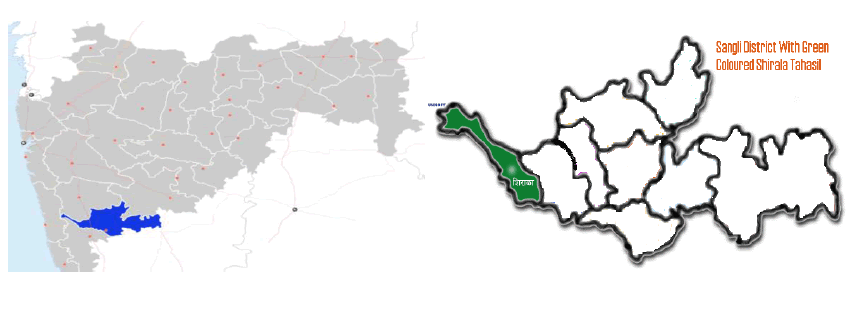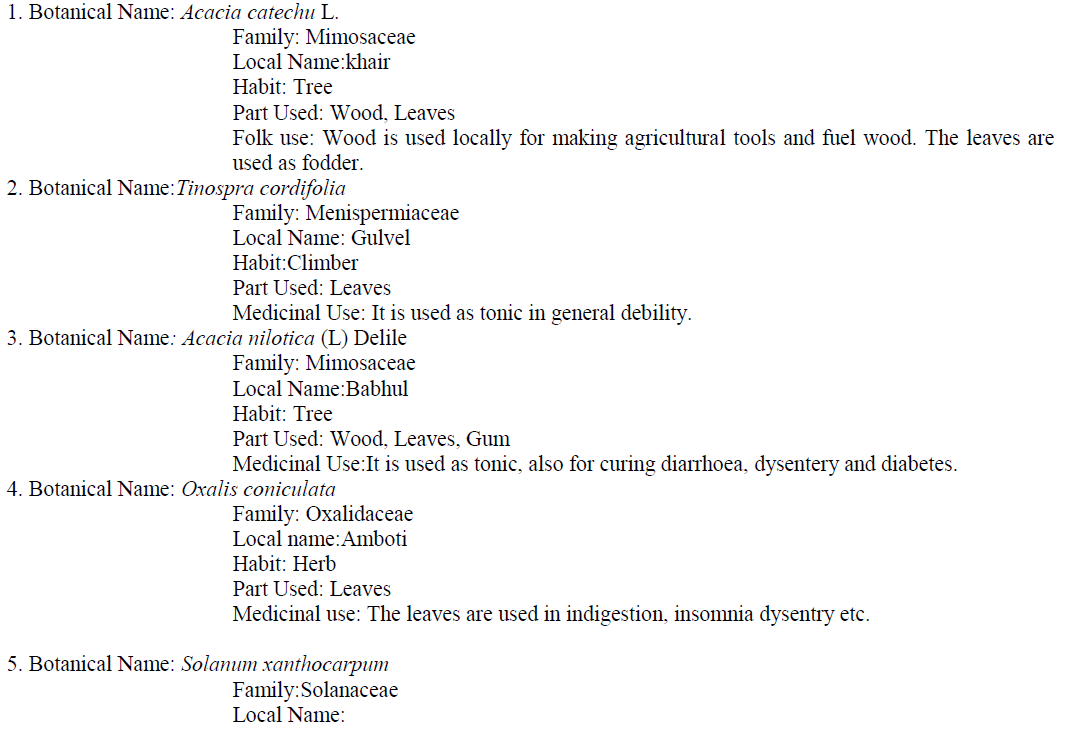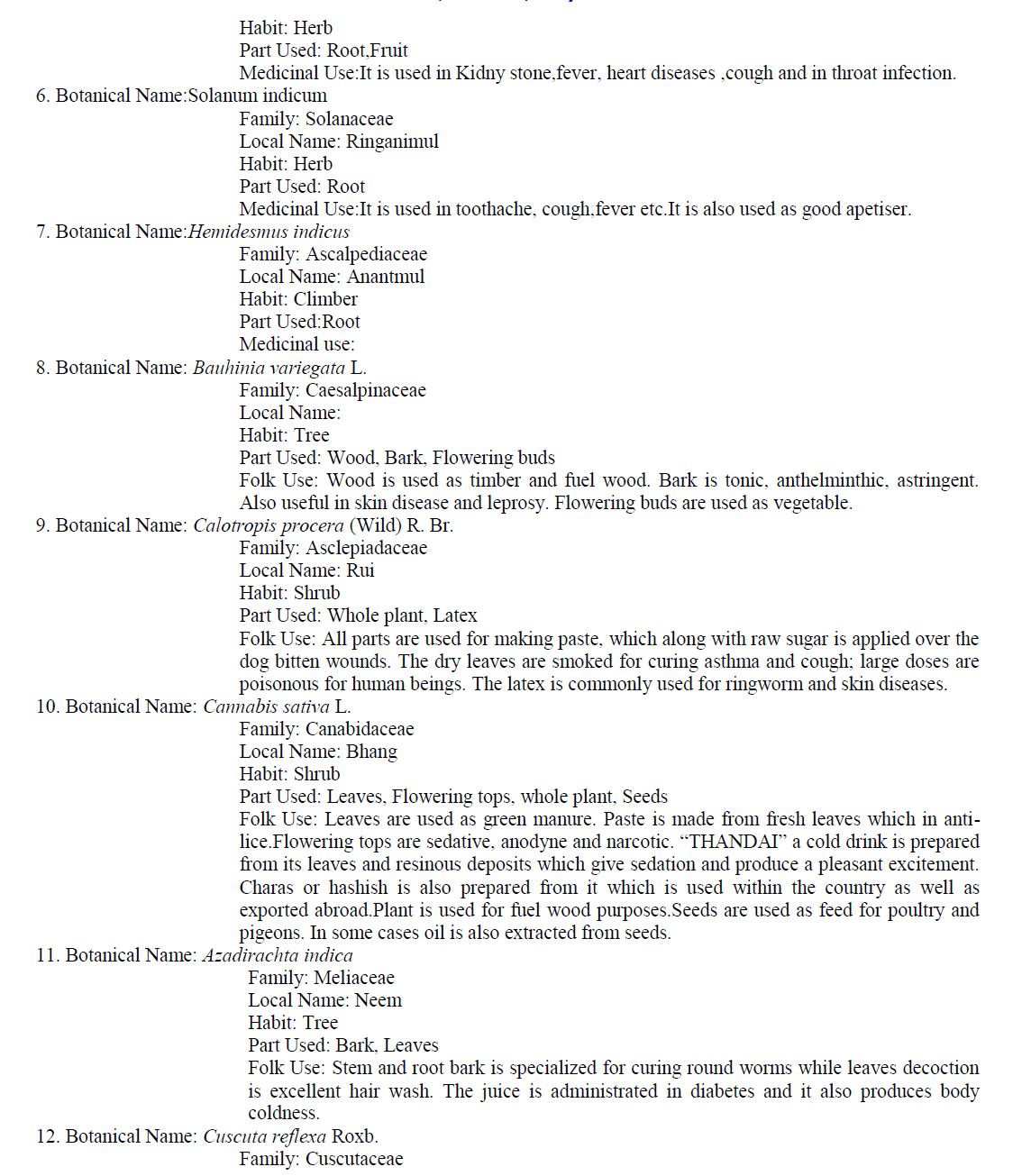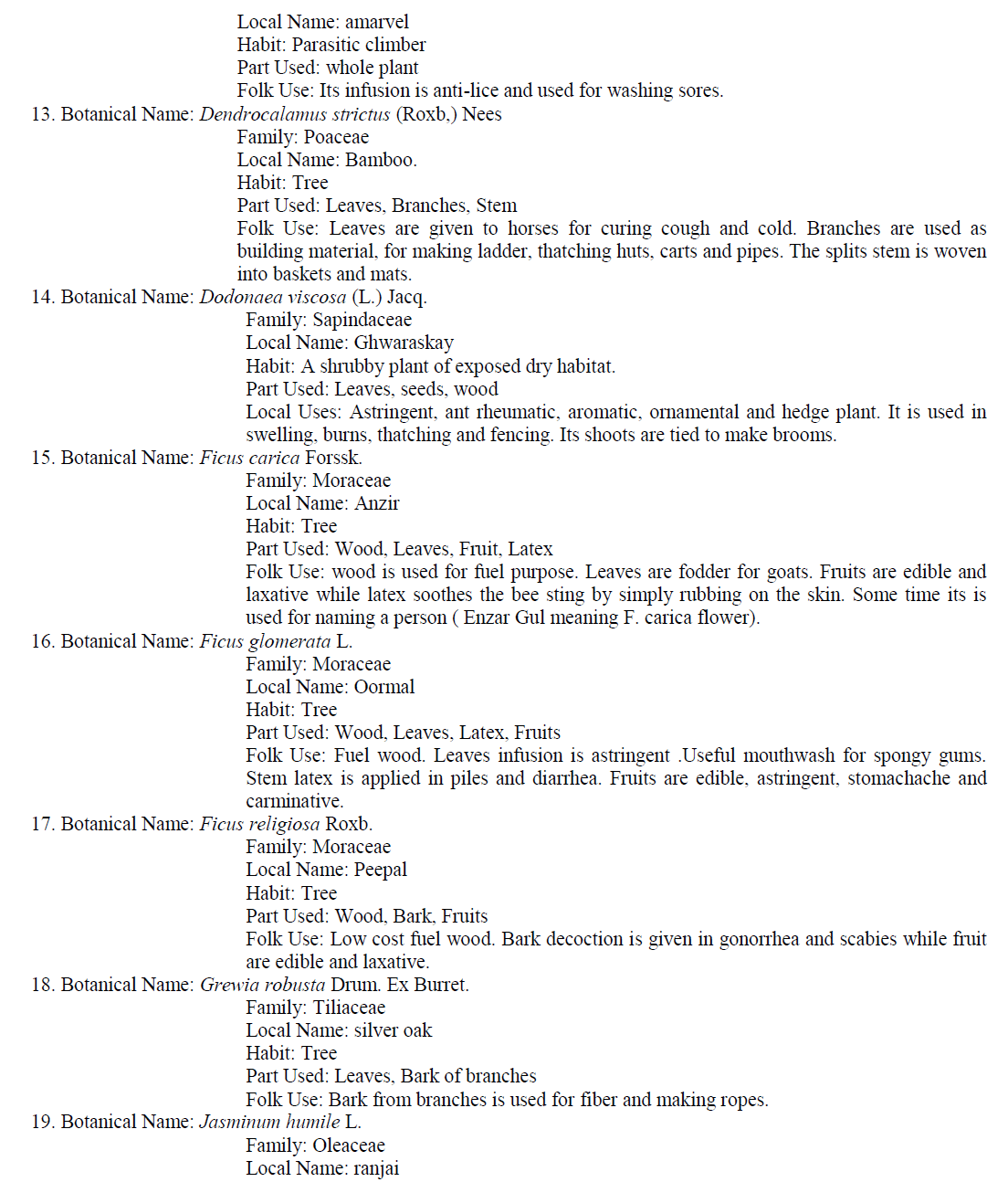ISSN ONLINE(2319-8753)PRINT(2347-6710)
ISSN ONLINE(2319-8753)PRINT(2347-6710)
Shubhangi R.Kamble1, Rekha R.Deokar1, Satish R.Mane2 and Sarjerao R. Patil3
|
| Related article at Pubmed, Scholar Google |
Visit for more related articles at International Journal of Innovative Research in Science, Engineering and Technology
The present study was carried out to assess and document ethno botanical knowledge of herbs,shrubs and trees from Shirala tahasil; as this area has diverse flora and high ethno botanical potential. It was found that different plant species are used for medicinal, timber, fuel wood, fodder, ornamental, agricultural tools, Thatching, fencing, naming (folk lore) and fruit yielding purposes. Many plant species show multiple medicinal uses like various plant parts are used for making herbal products and natural medicines. Such as leaves of Neem are used as an old and popular remedy for variety of disorders. Emblica officinalis is useful in diseases, burning sensation, hair fall etc. Acacia nilotica, Terminalia arjuna, T. bellarica, are used by local peoples for various purposes.
Keywords |
| Ethnobotany; Medicinal herbs, shrubs, trees, Shirala tahsil . |
INTRODUCTION |
| In India medicinal plants are utilized directly in folk remedies or indirectly in modern medicines. The herbal treatment has very deep roots in Indian culture. Importance of traditional and folk medicines in the treatment of various human ailments is well known from ancient time. Rural people from Shirala region uses plants in folk medicines, timber, fuel, fodder, agricultural tools, fencing and fruit yielding purposes A number of such plants have become endangered. The present study highlights the plants used by rural people for making herbal products and natural medicines. |
STUDY AREA |
| Shirala tahsil is located at hilly edges of sahyadri in Sangli district near the Chandoli dam, between longitude 730 40’ E and 730 53’ E and latitude 170.03’ N and 170 20’ N near Sangli in Western Maharashtra. It is one of the hot spot for biodiversity from Western Ghat |
 |
MATERIAL AND METHODS |
| The study area was visited several times for collection of data during the year 2011 to 2014. The plants were collected, pressed and later on identified. Questionnaires were adopted for documenting ethno botanical knowledge of the area. The data obtained was cross checked with available literature (2, 3, 4, 5, and 6). |
RESULT AND DISCUSSION |
| The ethno botany of various plant species were documented during the present investigation. The results follow: |
 |
 |
 |
| Habit: Wild ornamental climbing shrub |
| Part Used: Flowers, whole plant |
| Local Uses: Ornamental. Root decoction is used for curing ringworms. |
| 20. Botanical Name: Adhatoda zeylanica Nees . |
| Family: Acanthaceae |
| Local Name: Adulsa |
| Habit: shrub |
| Part Used: Root and leaves |
| Local Uses: Roots are used in rheumatism, pneumonia and cough. Leaves are applied to reduce swelling. The decoction of leaves is antispasmodic, expectorant, abortifacient and also used for curing dysentery in cattle. It is also used in scabbies and other skin disorders. Used in snakebites, eye and ear ailments. Antiseptic and insect repellent. Honey Bee species. |
| 21. Botanical Name: Luffa aegyptiaca Mill. |
| Synonym: L. cylindrica Roem. |
| Family: Cucurbitaceae |
| Local Name: Torai |
| Habit: A cultivated climbing vegetable |
| Part Used: Fruits |
| Folk Use: Fruits are used as vegetable, good for stomach and ulcer problems. Dried fruit case is used for cleaning utensils. |
| 22. Botanical Name: Mallotus philippensis (Lam.) Muell. |
| Family: Euphorbiaceae |
| Local Name: Kunkuphal |
| Habit: Tree,Fruits. |
| Part Used: WoodFolk Use: Used as fuel wood,fruits used to prepare red dye. |
| 23. Botanical Name: Melia azedarach L. |
| Family: Meliaceae |
| Local Name: Limbara |
| Habit: Tree |
| Part Used: Wood, Leaves, Fruit, Bark |
| Folk Use: Timber wood, used for making furniture and building materials. Medicinally used for curing fever. Leaves are used as fodder for goats and are carminative. Fruits are eaten by Nightingales in winter, also grind and fed to the goats. Bark is anthelmintic and poisonous with bitter taste. |
| 24. Botanical Name: Morus alba L. |
| Family: Moraceae |
| Local Name: Spin Toot |
| Habit: A cultivated or wild deciduous tree |
| Part Used: Fruits, leaves, branches, trunk |
| Folk Use: Fruits are eaten both fresh and dry. They are laxative, purgative. Leaves are emollient, used for cleaning throat, cooling agent, anthelmintic and astringent. Baskets are also made from the flexible branches. Wood is used in furniture. Leaves were once used in rearing silkworms. Leaves are eaten by goats and sheep. Planted as shade tree. |
| 25. Botanical Name: Nerium odoratum Mill. |
| Family: Apocyanaceae |
| Local Name: kanher |
| Habit: Shrub |
| Part Used: Whole plant |
| Folk Use: Ornamental but poisonous. The leaves decoction in the form of paste is applied externally on the skin to prevent skin diseases. |
| 26. Botanical Name: Opuntia dilleni Haw. |
| Family: Cactaceae |
| Local Name: Nivdung |
| Habit: Shrub |
| Part Used: Phylloclades, Fruits |
| Folk Use: Phylloclades poultice is used for extracting guinea worms. Fruits are edible, demulcent and expectorant. The ripe fruits juice is useful remedy for asthma and whooping cough |
| 27. Botanical Name: Ricinus communis L. |
| Family: Euphorbiaceae |
| Local Name: Arand. |
| Habit: A perennial herbaceous shrub |
| Part Used: Leaves, seeds, oil |
| Folk Use: Leaves are emetic, narcotic, poisonous and purgative. Poultice is applied to swellings. Castor oil is purgative, oil is given in constipation before and after child birth to mother. Seeds are sedative. |
| 28. Botanical Name: Rosa spp.J.Herm. |
| Family: Rosaceae |
| Local Name: Jangaley Gulab |
| Habit: Climbing shrub of hilly areas |
| Part Used: Flowers, branches |
| Folk Use: Ornamental, aromatic, used in fencing and hedges, Honey bee species. Used in naming i.e., Gulab Khan. |
| 29. Botanical Name: Vitex negundo L. |
| Family: Verbinaceae |
| Local Name: Nigadi |
| Habit: A medium sized shrub of water courses and graveyards |
| Part Used: Leaves, roots and branches |
| Local Uses: Fresh roots are used as bandage to relieve pain of chest and back, branches are used as toothbrush (Miswak), leaves are aromatic, febrifuge, diuretic and anthelmintic. Leaves are smoked to relieve headache. Flowers are astringent and tonic. Non-palatable, used for making shelters for tobacco seedlings. |
| 30. Botanical Name: Withania somnifera (L.) Dunal. |
| Family: Solanaceae |
| Local Name: Ashwagandha |
| Habit: Shrub |
| Part Used: Leaves fruits and roots |
| Local Uses: Leaves and roots are used as poultice to swellings, ulcers and carbuncles. The fruit is diuretic. The root is an aphrodisiac tonic, diuretic, narcotic and used in rheumatism. |
| 31. Botanical Name: Woodfordia fruiticosa (L) Kurz |
| Habit: Shrub |
| Part Used: Wood |
| Folk Use: Used as fuel wood species. |
| 32. Botanical Name: Zizyphus jujuba Mill. |
| Family: Rhamnaceae |
| Local Name: Bor |
| Habit: Tree |
| Part Used: Wood, leaves, roots, bark, fruits |
| Folk Use: Fuel wood. Fodder for goats. Edible, bloods purifier and cure indigestion. Fruit decoction is excellent hair wash and also used for bronchitis. Bark macerated in milk is given along with honey in diarrhea and dysentery. |
CONCLUSION |
| Plants provide us readymade food, medicines for ailment, fodder and forage for our domestic animals, fuel wood for burning, flowers for aesthetics and celebration, raw materials for many industries, timber for construction and many more useful items. Local people of Shirala tahsil are using these natural resources .However, it is now time to realize that the traditional knowledge and management system are as important as the need to introduce modern innovative approaches to sustainable development and management of natural resources in order to sustain the livelihood of traditional societies .People use plants in many ways such as medicinal, timber wood, fuel wood, food, fodder etc. So there is a great impact of human life on local vegetation as well as local vegetation influence human life (1). |
ACKNOWLEDGEMENTS |
| The authors are grateful to the local people of the Shirala region who contributed and gave information about the plants. |
References |
|